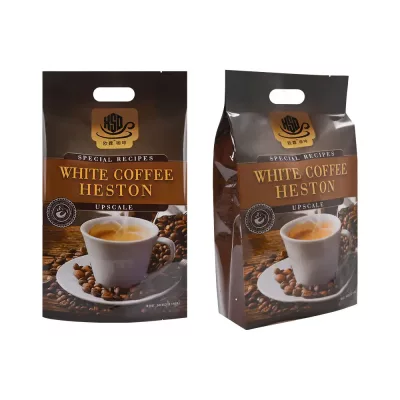Coffee packaging plays a crucial role in maintaining the freshness, flavor, and aroma of coffee beans or grounds. Choosing the right packaging material is essential for both coffee producers and consumers. Among the most common options are paper coffee bags and foil coffee bags. Each type has distinct characteristics that make it suitable for different needs.
1. Material Composition
Paper Coffee Bags
Paper coffee bags are typically made from kraft paper or other types of lined paper. These bags are often praised for their eco-friendliness, as kraft paper is biodegradable and recyclable. Some paper bags also come with a thin plastic lining to improve their moisture resistance, but this can affect their environmental benefits. Paper coffee bags are a popular choice among brands that prioritize sustainability and wish to project an environmentally conscious image.
Foil Coffee Bags
Foil coffee bags are made from layers of aluminum foil and plastic, creating a multi-layered structure designed to provide superior protection against external elements. The aluminum foil layer acts as a barrier against oxygen, moisture, and light, all of which can degrade the quality of coffee. The plastic layer adds durability and flexibility to the bag. Although foil coffee bags offer excellent protection, they are less environmentally friendly due to the difficulty of recycling multi-layer materials.

2. Barrier Properties
Paper Coffee Bags
While paper coffee bags offer some protection, they are generally less effective at blocking out oxygen and moisture compared to foil bags. The natural permeability of paper means that over time, air and moisture can seep through, potentially leading to stale or less flavorful coffee. However, for short-term storage or quick consumption, paper bags can be adequate, especially if lined with additional materials like plastic or wax.
Foil Coffee Bags
Foil coffee bags excel in providing a robust barrier against environmental factors that can compromise coffee quality. The aluminum foil layer is impermeable to oxygen and moisture, significantly extending the shelf life of coffee. By protecting the beans from light and air, foil bags help maintain the coffee’s freshness, aroma, and flavor profile for a much longer period than paper bags. This makes them ideal for long-term storage, shipping, and large-scale distribution.
3. Environmental Impact
Paper Coffee Bags
Paper coffee bags are often favored for their lower environmental impact. Kraft paper, in particular, is biodegradable and can be composted, making it an attractive option for eco-conscious brands and consumers. Even when lined with a thin plastic layer, paper bags still offer better recyclability than their foil counterparts. As the world shifts towards more sustainable practices, paper coffee bags are becoming increasingly popular in the market.
Foil Coffee Bags
Despite their protective benefits, foil coffee bags pose environmental challenges. The combination of aluminum and plastic makes these bags difficult to recycle, as the layers must be separated during the recycling process, which is not always feasible. Additionally, foil bags are non-biodegradable, contributing to long-term waste in landfills. Brands that choose foil coffee bags may need to consider the trade-off between superior product protection and environmental responsibility.
4. Customization and Branding
Paper Coffee Bags
One of the advantages of paper coffee bags is their versatility in customization. The surface of kraft paper is ideal for printing, allowing for clear, vibrant designs that resonate with brand identity. Many artisanal and small-scale coffee producers opt for paper bags because they can be easily branded with eco-friendly inks, giving the product a rustic, natural look that appeals to consumers who value sustainability.
Foil Coffee Bags
Foil coffee bags also offer excellent customization options, with the added benefit of achieving high-quality, glossy finishes. The combination of aluminum and plastic allows for intricate, eye-catching designs that can make a product stand out on the shelf. Brands that want to convey a premium image often choose foil bags for their ability to showcase bright colors and detailed graphics. However, this premium look comes with a higher cost and a larger environmental footprint.
5. Cost Considerations
Paper Coffee Bags
In terms of cost, paper coffee bags are generally more affordable, particularly for smaller orders. The simplicity of the materials and the ease of production make paper bags a cost-effective option for brands looking to minimize expenses while still offering a quality product. For businesses focused on sustainability, the lower cost of paper bags can be an added incentive.
Foil Coffee Bags
Foil coffee bags, on the other hand, tend to be more expensive due to the complexity of their construction and the quality of materials used. The cost reflects the superior protection and premium appearance that foil bags provide. For large-scale producers or those selling high-end coffee products, the investment in foil bags may be justified by the longer shelf life and enhanced brand perception.
6. Suitability for Different Types of Coffee
Paper Coffee Bags
Paper coffee bags are best suited for short-term storage or for coffee that is meant to be consumed relatively quickly after roasting. They are ideal for smaller, local roasters who sell their products at markets or directly to customers, where freshness is not a long-term concern. For brands that emphasize sustainability and local production, paper bags align well with their values.
Foil Coffee Bags
Foil coffee bags are the preferred choice for long-term storage, shipping, and large-scale distribution. They provide the necessary protection to keep coffee fresh during extended periods, making them ideal for exporters and larger producers. If a brand’s priority is to ensure the maximum shelf life and maintain the highest quality for their coffee, foil bags are the way to go.
Both paper and foil coffee bags have their unique advantages and drawbacks. Paper bags are environmentally friendly, cost-effective, and perfect for short-term use, while foil bags offer superior protection, a premium look, and extended shelf life. When choosing between the two, consider your brand’s priorities, the type of coffee you’re packaging, and your target market.
